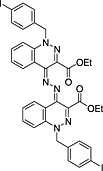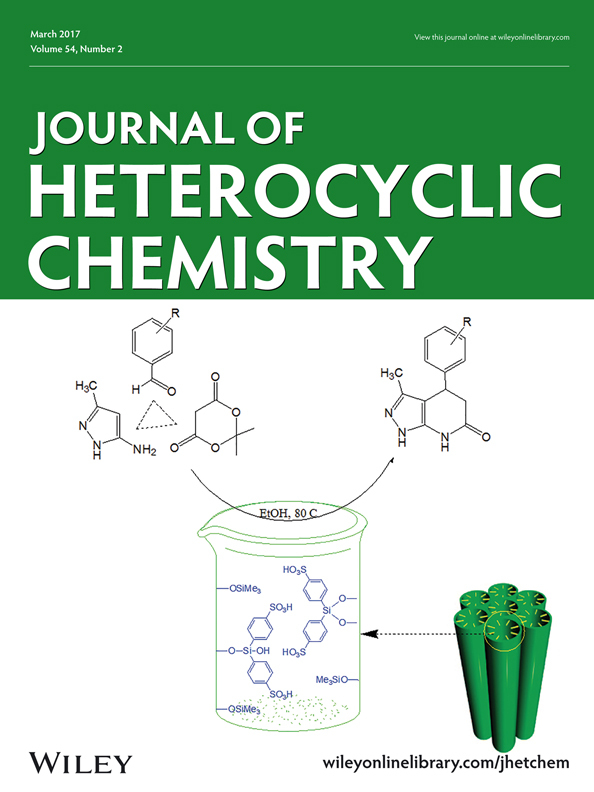2,5-Disubstituted Pyrazolo[4,3-c]cinnolin-3-ones
Corresponding Author
Douglas C. Beshore
Department of Medicinal Chemistry, Merck Research Laboratories, West Point, PA, 19486 USA
E-mail: [email protected]Search for more papers by this authorAdam W. Johnson
Department of Medicinal Chemistry, Merck Research Laboratories, West Point, PA, 19486 USA
Search for more papers by this authorRobert M. DiPardo
Department of Medicinal Chemistry, Merck Research Laboratories, West Point, PA, 19486 USA
Search for more papers by this authorDaniel R. Pitts
Department of Medicinal Chemistry, Merck Research Laboratories, West Point, PA, 19486 USA
Search for more papers by this authorVictoria Cofre
Department of Medicinal Chemistry, Merck Research Laboratories, West Point, PA, 19486 USA
Search for more papers by this authorScott D. Kuduk
Department of Medicinal Chemistry, Merck Research Laboratories, West Point, PA, 19486 USA
Search for more papers by this authorCorresponding Author
Douglas C. Beshore
Department of Medicinal Chemistry, Merck Research Laboratories, West Point, PA, 19486 USA
E-mail: [email protected]Search for more papers by this authorAdam W. Johnson
Department of Medicinal Chemistry, Merck Research Laboratories, West Point, PA, 19486 USA
Search for more papers by this authorRobert M. DiPardo
Department of Medicinal Chemistry, Merck Research Laboratories, West Point, PA, 19486 USA
Search for more papers by this authorDaniel R. Pitts
Department of Medicinal Chemistry, Merck Research Laboratories, West Point, PA, 19486 USA
Search for more papers by this authorVictoria Cofre
Department of Medicinal Chemistry, Merck Research Laboratories, West Point, PA, 19486 USA
Search for more papers by this authorScott D. Kuduk
Department of Medicinal Chemistry, Merck Research Laboratories, West Point, PA, 19486 USA
Search for more papers by this authorAbstract
Complementary strategies to 2,5-disubstituted pyrazolo[4,3-c]cinnolin-3-ones are reported herein, providing late stage substituent introduction at either the 2- or the 5-position. Treating a readily prepared 4-thiocinnoline ester with substituted hydrazines afforded late stage access to the 2-position, while late stage substituent introduction at the 5-position was achieved via two different strategies: alkylation of 4-hydrazonopyrazol-3-ones, followed by a ring-closing intramolecular SNAr tactic and direct reaction of 5-(2-fluorophenyl)-2,4-dihydro-3H-pyrazol-3-ones with aryl diazonium salts, followed by cyclization. The strategies described herein provide practical and general methods to prepare 2,5-disubstituted pyrazolo[4,3-c]cinnolin-3-ones.
Supporting Information
| Filename | Description |
|---|---|
| jhet2744-sup-0001-Supplementary.pdfPDF document, 884.3 KB |
Supporting info item |
Please note: The publisher is not responsible for the content or functionality of any supporting information supplied by the authors. Any queries (other than missing content) should be directed to the corresponding author for the article.
References and Notes
- 1 Preliminarily disclosure of this work has been reported: Pitts, D. R.; DiPardo, R. M.; Johnson, A. W.; Cofre, V.; Beshore, D. C. Abstracts of Papers, 240th ACS National Meeting, Boston, MA, United States, August 22–26, 2010, ORGN-976.
- 2Blurton, P.; Fletcher, S. R. Preparation of tricyclic pyrazolo-pyridazinone analogs as GABAA receptor ligands. PCT Int Appl 1999, WO 9900391 A1 19990107.
- 3Mathews, I. R. Preparation of oxopyrazolocinnolines as CD80 inhibitors useful as immunomodulators. PCT Int Appl 2004 WO 2004081011 A1 20040923.
- 4Huxley, P.; Sutton, D. H.; Debnam, P.; Matthews, I. R.; Brewer, J. E.; Rose, J.; Trickett, M.; Williams, D. D.; Andersen, T. B.; Classon, B. J. Chem Biol 2004, 11, 1651.
- 5 Treatment of 8a with phosphorus oxychloride and subsequent treatment with a substituted hydrazine did not lead to pyrazolo[4,3-c]cinnolin-3-one formation; data not shown.
- 6Miyamoto, T.; Matsumoto, J. Chem Pharm Bull 1988, 36, 1321.
- 7 For a general review of cinnoline chemistry see: N. Haider and W. Holzer, Sci Synth, Product Class 9: Cinnolines 16, 2004, p. 251.
- 8Dowlatshahi, H. A. Synth Commun 1985, 15, 1095.
- 9Gyorkos, A. C.; Corrette, C. P.; Cho, S. Y.; Turner, T. M.; Aso, K.; Kori, M.; Gyoten, M.; Condroski, K. R.; Siedem, C. S.; Boyd, S. A. PCT Int Appl, 2005, WO 2005099688 A2 20051027.
- 10Ohsumi, T.; Neuhoeffer, H. Tetrahedron 1992, 48, 651.
- 11Crespo, M. I.; Gràcia, J.; Puig, C.; Vega, A.; Bou, J.; Beleta, J.; Doménech, T.; Ryder, H.; Segarra, V.; Palacios, J. Bioorg Med Chem Lett 2000, 10, 2661.
- 12Pedersen, B. S.; Scheibye, S.; Nilsson, N. H.; Lawesson, S. O. Bull Soc Chim Belg 1978, 87, 223.
- 13 When Conditions A from Table 2 were employed, exclusive formation of dimer was observed by LC/MS (see below). Employing excess hydrazine (40 equiv) in ethanol suppressed dimer formation.
- 14 Data not shown.
- 15Satchell, D. P. N.; Satchell, R. S. Chem Soc Rev 1990, 19, 55.
- 16Corey, E. J.; Bock, M. G. Tetrahedron Lett 1975, 16, 2643.
10.1016/S0040-4039(00)75203-8 Google Scholar
- 17Bülow, C.; Göller, H. Ber 1911, 44, 2835.
10.1002/cber.191104403125 Google Scholar
- 18Grob, C. A.; Rumpf, J. A. Helv Chim Acta 1954, 174, 1479.
- 19Beshore, D.; DiPardo, R.; Kuduk, S. Tetrahedron Lett 2010, 51, 970.
- 20Raushel, J.; Pitram, S. M.; Fokin, V. V. Org Lett 2008, 10, 3385.
- 21Schmitz, A.; Kraatz, U.; Korte, F. Heterocycles 1978, 10, 199.
- 22Rawal, V. H.; Jones, R. J.; Cava, M. P. J Org Chem 1987, 52, 19.
- 23 A one-pot protocol for this transformation was also attempted without aqueous workup after the alkylation step. However, this protocol afforded lower isolated yields of 18ai (yields not shown).
- 24 The alkylation of 17g with propynylbromide proceeded well (LC/MS analysis of the reaction mixture); however, the instability of the deprotected homopropynyl amine to the cyclication conditions is likely the reason for the low isolated yield of 18c.
- 25 Aryl diazonium salts were prepared according to the procedures described herein: Tang, Z.Y.; Zhang, Y.; Wang, T.; Wang, W. Synlett 2010, 5, 0804.
- 26 Lower temperatures (i.e., 70 °C) did not promote cyclization.
- 27Grob, C. A.; Rumpf, J. A. Ber 1911, 44, 2835.
10.1002/cber.191104403125 Google Scholar





